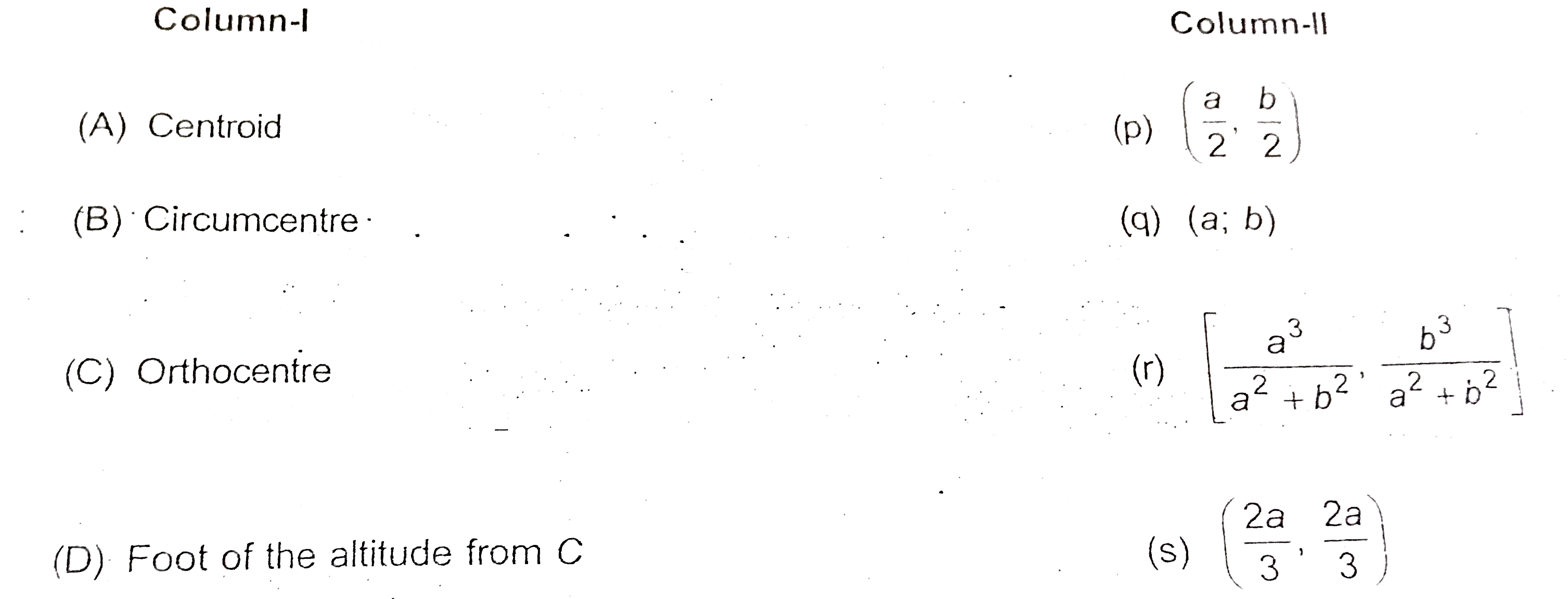a and b are real numbers between 0 and 1 A(a,1),B(1,b)andC(0,0) are the vertices of a triangle.
If ΔABC is equilateral its area is
7√3+124
8√3−124
√34
√32
The correct Answer is:B
To find the area of the equilateral triangle formed by the points A(a, 1), B(1, b), and C(0, 0) where a and b are real numbers between 0 and 1, we can follow these steps:
Step 1: Calculate the lengths of the sides of the triangle
1. Length of AB:
AB=√(a−1)2+(1−b)2
2. Length of BC:
BC=√(1−0)2+(b−0)2=√1+b2
3. Length of AC:
AC=√(a−0)2+(1−0)2=√a2+1
Step 2: Set the lengths equal for an equilateral triangle
Since triangle ABC is equilateral, we have:
AB=BC=AC
Step 3: Equate AB and BC
√(a−1)2+(1−b)2=√1+b2
Squaring both sides:
(a−1)2+(1−b)2=1+b2
Expanding:
(a2−2a+1)+(1−2b+b2)=1+b2
This simplifies to:
a2−2a+2−2b=1
Thus:
a2−2a−2b+1=0(1)
Step 4: Equate BC and AC
√1+b2=√a2+1
Squaring both sides:
1+b2=a2+1
This simplifies to:
b2=a2⇒b=a(since a,b are positive)
Step 5: Substitute b = a into equation (1)
Substituting b=a into equation (1):
a2−2a−2a+1=0
This simplifies to:
a2−4a+1=0
Step 6: Solve the quadratic equation
Using the quadratic formula:
a=−b±√b2−4ac2a=4±√(−4)2−4⋅1⋅12⋅1
=4±√16−42=4±√122=4±2√32=2±√3
Step 7: Determine valid values for a
Since a must be between 0 and 1:
- 2+√3 is not valid (greater than 1).
- 2−√3 is valid (approximately 0.268).
Step 8: Calculate the area of the triangle
Using the formula for the area of an equilateral triangle:
Area=√34×side2
Where the side length can be calculated as:
AC=√(2−√3)2+1=√(2−√3)2+1=√(4−4√3+3+1)=√8−4√3
Thus, the area becomes:
Area=√34×(8−4√3)
Final Area Calculation
After simplifying:
Area=√34×(8−4√3)=8√34−124=2√3−3
Conclusion
The area of triangle ABC is:
Area=2√3−3
1. Length of AB:
AB=√(a−1)2+(1−b)2
BC=√(1−0)2+(b−0)2=√1+b2
AC=√(a−0)2+(1−0)2=√a2+1
Since triangle ABC is equilateral, we have:
AB=BC=AC
√(a−1)2+(1−b)2=√1+b2
Squaring both sides:
(a−1)2+(1−b)2=1+b2
Expanding:
(a2−2a+1)+(1−2b+b2)=1+b2
This simplifies to:
a2−2a+2−2b=1
Thus:
a2−2a−2b+1=0(1)
√1+b2=√a2+1
Squaring both sides:
1+b2=a2+1
This simplifies to:
b2=a2⇒b=a(since a,b are positive)
Substituting b=a into equation (1):
a2−2a−2a+1=0
This simplifies to:
a2−4a+1=0
Using the quadratic formula:
a=−b±√b2−4ac2a=4±√(−4)2−4⋅1⋅12⋅1
=4±√16−42=4±√122=4±2√32=2±√3
Since a must be between 0 and 1:
- 2+√3 is not valid (greater than 1).
- 2−√3 is valid (approximately 0.268).
Using the formula for the area of an equilateral triangle:
Area=√34×side2
Where the side length can be calculated as:
AC=√(2−√3)2+1=√(2−√3)2+1=√(4−4√3+3+1)=√8−4√3
Thus, the area becomes:
Area=√34×(8−4√3)
After simplifying:
Area=√34×(8−4√3)=8√34−124=2√3−3
The area of triangle ABC is:
Area=2√3−3
Topper's Solved these Questions
- STRAIGHT LINESBOOK - AAKASH INSTITUTE ENGLISHCHAPTER - STRAIGHT LINESEXERCISE - SECTION-E (ASSERTION-REASON TYPE QUESTIONS)
6 Videos
- STRAIGHT LINESBOOK - AAKASH INSTITUTE ENGLISHCHAPTER - STRAIGHT LINESEXERCISE - SECTION-F (MATRIX-MATHC TYPE QUESTION)
3 Videos
- STRAIGHT LINESBOOK - AAKASH INSTITUTE ENGLISHCHAPTER - STRAIGHT LINESEXERCISE - ASSIGNMENT (SECTION C) (OBJECTIVE TYPE QUESTIONS) (MORE THAN ONE ANSWER)
14 Videos
- STATISTICSBOOK - AAKASH INSTITUTE ENGLISHCHAPTER - STATISTICSEXERCISE - Section-C Assertion-Reason
15 Videos
- THREE DIMENSIONAL GEOMETRY BOOK - AAKASH INSTITUTE ENGLISHCHAPTER - THREE DIMENSIONAL GEOMETRY EXERCISE - ASSIGNMENT SECTION - J
10 Videos
Similar Questions
a and b are real numbers between 0 and 1 A(a,1),B(1,b)andC(0,0) are the vertices of a triangle.
If ∠C=90∘ then
View Solutiona and b are real numbers between 0 and 1 A(a,1),B(1,b)andC(0,0) are the vertices of a triangle.
If ΔABCis isosceles with AC=BCand5(AB)2=2(AC)2 then
View SolutionLet A(0,β),B(−2,0) and C(1,1) be the vertices of a triangle. Then
Angle A of the triangle ABC will be obtuse if β lies in
View SolutionProve that the points A(1,−3),B(−3,0)andC(4,1)are the vertices of a right angled Isosceles triangle
View SolutionThe vertices of a triangle are (1, 0), (4, 0) and (4, 4). Its area is :
View SolutionLet A(1,2,3),B(0,0,1)andC(−1,1,1) are the vertices of △ABC.
Q. The area of(△ABC) is equal to
View SolutionThe vertices of a triangle are A(a,0)B(0,b)andC(a,b)

View Solutiona and b are real numbers between 0 and 1 such that the points Z1=a+i, Z2=1+bi, Z3=0 form an equilateral triangle, then a and b are equal to
View SolutionProve that the points A(1,1),B(−1,−1)andC(√3,−√3) are the vertices of an equilateral triangle.
View SolutionShow that the points A(2,-1,3),B(1,-3,1) and C(0,1,2) are the vertices of an isosceles right angled triangle.
View Solution
